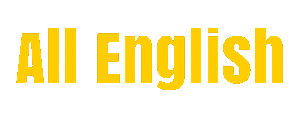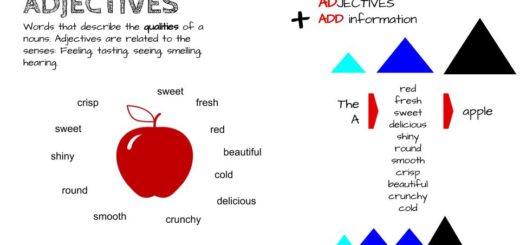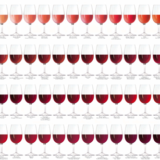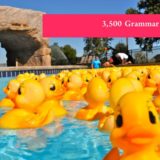Grammar Byte: Parts of Speech
There are different kinds of words, according to the particular part (or role) a given word plays when it is used in speech or writing. We give each kind of word a label that shows which part of speech that word is. The parts of speech are noun, verb, adjective, adverb, pronoun, preposition, conjunction, and interjection.
In the picture, I’ve represented each part of speech with a shape. These symbols come from a teaching system called Montessori. Words or parts of speech appear in patterns and sometimes it’s easier to understand or see a pattern when it’s represented visually. For example, triangles representing an article, adjective and noun, always seem to be in the same order. Where an adverb appears, it often sits beside a verb.
The noun family consists of determiners, adjectives nouns, and pronouns. I call it a family because, as you can see from the example above, they always hang out together.
A noun is a word for a person, place, thing, animal or idea. Proper nouns (ex. names of people or countries) always start with a capital letter; common nouns do not. Nouns can be singular or plural (ex. cat/cats), concrete or abstract (ex. piece/peace). Nouns show possession by adding ‘s. Because nouns are usually solid, tangible things, they are represented by a triangle. A triangle, like a pyramid, has a solid base and doesn’t move. The noun is the most important part of the noun family, so you can think of a noun as being the mother of the family. Determiners and adjectives have triangle shapes as well because they are related to the noun.
A pronoun is a a word that replaces a noun in a sentence. Some examples of pronouns include I, me, mine, myself, she, her, hers, herself, we, us, ours and ourselves. Pronouns are used so that you don’t have to repeat nouns over and over when talking. So instead of saying, “Eric and Tammy saw Melissa. Eric and Tammy said hello to Melissa,” we can shorten things up by saying, “Eric and Tammy saw Melissa. They said hello to her.”
Determiners are words that express information about a noun, such as definiteness, proximity, relationship and quantity. You can think of a determiner like a baby. It is almost always with the mother noun. For example, the dog, this shoe, my house.
Articles are a specific type of determiner. The three articles are the, a, and an.
Adjectives are words that describe or modify the quality of nouns. They are like teenagers: sometimes they hang out with mother noun and sometimes not. Examples of adjectives are red shoes, nice person, big house.
Verbs are words that show action or being. For example, “He ate (action) a sandwich.” Or “She was (being) sad.” There is a main verb and sometimes one or more helping verbs. (ex. “She can dance.” Dance is the main verb; can is the helping verb.) Verbs also take different forms to express tense, ex. died (past), die (present), will die (future). Because verbs are related to action, they are circular. They can roll and move. Verbs give a sentence life, so they are red, a color that symbolizes life (blood).
An adverb describes or usually modifies a verb, but can also modify an adjective, or another adverb. It usually answers the questions of when, where, how, and why. Adverbs often end in -ly, although it is becoming very common to drop the -ly in spoken English (ex. Apple’s motto: Think different.) Adverbs are the most movable of all parts of speech; they can occur in many positions in a sentence. However, because they are related to verbs they are usually around the verb. That’s why they are a small circle: an adverb moon orbiting around the verb planet.
A conjunction is a joining word. It joins two words or ideas together, so its shape is a small pink bar which represents a link in a chain. Conjunctions include for, and, nor, but, or, yet, so. You can remember these with the acronym FANBOYS.
A preposition is a word placed before a noun or pronoun to form a phrase that modifies another word in the sentence. Therefore a preposition is always part of a prepositional phrase. A prepositional phrase functions as an adjective or as an adverb. The preposition is a green crescent to symbolize a bridge. Prepositions are often combined with verbs to create new verbs (called phrasal verbs) with a different meaning, ex. make up (compensate), make for (head in a direction), make out (perceive), make of (think), etc.
An interjection is a part of speech that indicates the emotion or feeling of a speaker. Examples include: hey, hmm, eww, ahh, oops, eh, jeez, brr, ya-no, yippee, aww, aha. Unlike any all the other parts of speech, an interjection does not interact with any other words in a sentence. These one or two syllable words can encapsulate a very complex concept. For example, “Eww!” can mean “I am so completely disgusted by that gross thing whatever it is that I think that I just might throw up!” The symbol is a gold triangle with a circle on top; it combines the symbols of the noun and the verb together.
















